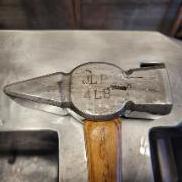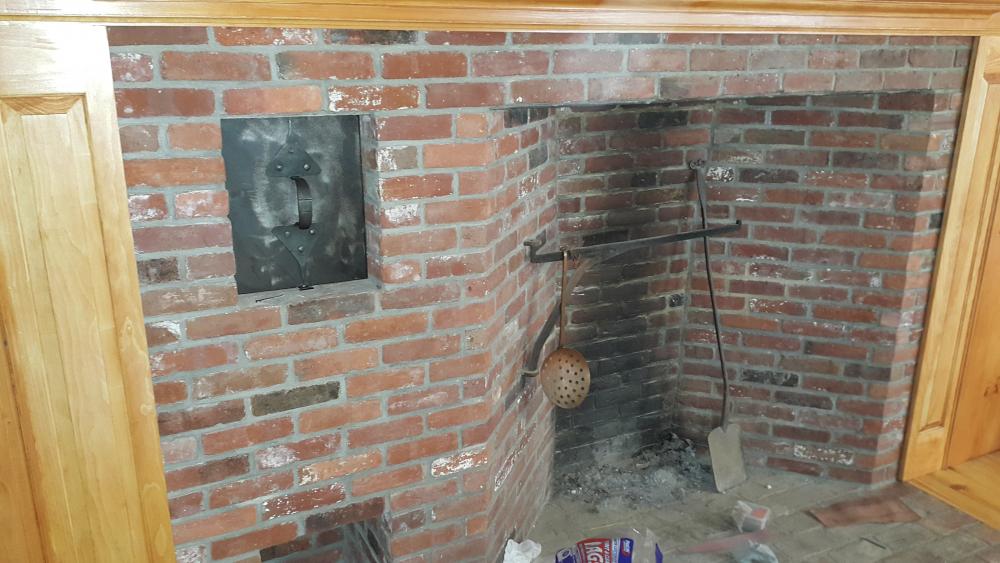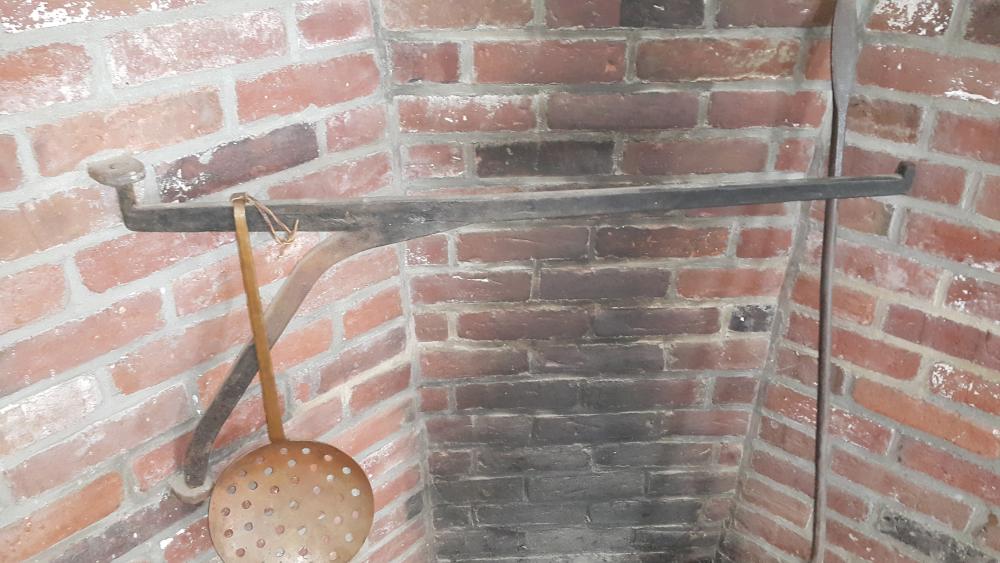-
Posts
5,782 -
Joined
-
Last visited
Content Type
Profiles
Forums
Articles
Gallery
Downloads
Events
Everything posted by jlpservicesinc
-
They make a self aligning dual roller contact bearing that might work well.. I've never considered putting a real bearing on the lead screw.. Nice fix, and great looking feather.. The washer that broke depending on the vise manufacturer and year made some were cast iron and some malleable iron.. Of course some were wrought iron but again depends on year produced..
-
nice and congrats on getting it done..
-
Nice work.. I love that guy also..
-

Blacksmithing Myths
jlpservicesinc replied to Francis Trez Cole's topic in Blacksmithing, General Discussion
You'll go to Hades for hitting a cold anvil (working cold steel).. -
This is a "how to" On forging chain makers tongs.. not the only way.. just one way.. These are the tongs used in the video "How to make chain" They are made for 3/8" chain but can be used up 2 standard sizes or anything between 3/8" and 1/2". https://youtu.be/u5ZcvmwIaV8
-

How to forge a 2 Tine roasting fork
jlpservicesinc replied to jlpservicesinc's topic in Blacksmithing, General Discussion
Thanks.. Please keep in mind these are "How to's" not production runs.. These videos I hope are for someone who is just starting out or for reference.. It's okay to be finicky and to take your time to make things just right,, to change things so they look good to your eye though they would be perfectly acceptable to someone else. Also to strive for a nearly finished product when done forging, so you don't have to spend so much time cleaning something up.. It was nothing to clean up and if you look at the last part of the video you can see as the fork sat on the anvil it actually had a patina from heat still left in it.. I believe the old adage is " 5minutes at the forge is 1hr at the bench".. or something like that.. I charge by the hour so taking the extra time just means it cost more to purchase and so I make more profit. Thanks... I really like the PIP also.. -
I have been in the process of making a bunch of "How To" videos on stuff I find interesting to make and also videos I'd want to watch.. The videos are picture in picture and usually there is a 2D version and a 3D version for people who have a 3D tv or VR Headset.. I don't have a VR head set so don't know if they play/work or not.. I can tell you some people on MAC computers have a hard time with the 3D videos.. Not sure why, but they can play the 2D ones just fine.. The cameras are 3D cameras and designed for regular day light.. Some of the video will be grainy but it's still winter here and there is no lights in the shop other than day light when it's nice enough.. Also you may notice ice in the water tub that is frozen.. The shop has no electric.. Who needs it anyway.. Please leave feedback, good, bad, what ever.. Here's the link https://youtu.be/dCJ_CXXIRRQ
-
My Pleasure.. More on the way..
-
I'll get them.. next NEB show...
-
Nice.. My first anvil was 10lbs.. I used to have to chase it across the floor..
-
Look at the rods used to help lock together all the timbers and masonry.. 2 on one end and then the shorter and longer ones on the edge of the photo.. I was out exploring a factory area looking for wrought iron pieces few days back when coming back from horses.. The mills were established back in the 1700's but had been destroyed several times.. Once by fire and then once with floods and then again with fire from what I can figure.. Anyhow the Dam was an earthen ware dam and like many dams back then didn't handle flood waters well.. It pretty much washed away the complete dam other than a few concrete pieces.. In the rubble I found a wagon tire with a part of a wooden fellow still attached but deeper in the pile there are tie rods.. Because we are still in winter here and the rods were buried under rocks I left them.. Anyhow, I am always amazed on exploring old sites.. In certain areas like this one the area was picked clean with only stuff they deemed to hard to retreive left behind.. other areas there is stuff just laying there in piles.. A lot of farms and town houses had their own dumps (99%) of them did.. on their own property with a burn pit.. Lots of the people I had worked for in the past discovered a crane sitting in the burn pit..
-
Thomas, I'm to old and to tired to even try to give a reasonable run for the money. I have books from Bethlehem steel, and a few others but since What I am doing works. " I don't bother" . I'll continue.. I'm still using knives and stuff I made when I was 10.. I have punches and hot chisels and swords over 30 years old which shouldn't work because i didn't follow the rules and used mystery metal.. As for A36 it works ok.. Welding it is a little different but once figured out it's just fine.. Really I think it comes down to what is important to the person.. I used to be one of those people who used to read everything they could and practice it both in hand and in conversation as to the merits of this vs that with the few smiths I did get to know... Also could tell you the 15 different chisel names used before milling machines and such came on the scene.. have made files by hand and hacksaw blades... My point is this far along in my life I've forgotten more than I know and while it is kind of fun for me to share who made oval eye hammers.. or why wrought iron is a great learning tool and why mystery metal is awesome.. It's because I don't think a smith or newbie should be limited by what someone says is "correct or not".. Just there are better ways, or faster ways, or easier ways.. I'm self taught as a blacksmith, spent 3 years learning the farrier trade and then went out and figured out on my own why horses feet have so many abnormalities and simple ways to cure most of them. I'm not a restless soul.. I just don't settle for what status quo dictates as the norm.. It's part of my character.. Never give up, never surrender.. Merely bend or move to a better position, recoup, rethink, apply.. Rinse and repeat.. Anyhow, now I'm happy just doing what I do and I work with all sorts of steels and alloys( 4140, A2, D2, S7, H13, W1, 5160, HSS) copper, bronze, brass, aluminum etc, etc. I still stick to my original statements and while technology has come a long ways and while much of it is assumed knowledge based on example.. No one can really say since it's in the past.. Also on that note.. Time and time again.. Engineers change their minds, make mistakes, and just plain old mess up.. Revisions and reprints.. time and time again.. Well yah, duh it's called a learning curve.. Well this didn't work so we should do this instead.. Sometimes good things come from it. Sometimes they don't.. Anyhow, Thanks for you input and adding to the knowledge pile.. It's all good when someone can benefit in the end.. and it's been a pleasure and you certainly know your technical goodies. NICE!!!!!!
- 32 replies
-
- heat treating
- forging carbon steel
-
(and 1 more)
Tagged with:
-
On my way to work today I was going over this thread in my mind.. Also the whole of blacksmith scene.. At that moment I started to realize how Rip Van Winkle must have felt..
- 32 replies
-
- heat treating
- forging carbon steel
-
(and 1 more)
Tagged with:
-
Thats a great idea.. Especially at a show..
-
Its a nice spring time color.. Very festive.. And I totally agree be nice to get a few more with polish on.. Sadly between my regular farrier work and the blacksmithing stuff it just doesn't last..
-
Don't grease her.. She's an oil eater.. Grease would just mess things up.. ideally you want an oil compatible with Worm gears.. I use Mobil SHC 460, though a lighter weight would work very well. That's the little sister to the 400.. Same gear box, just smaller housing.. At least that's the way ti looks in the pictures.. Nice blower by the way..
-
Chalk it up to "To much caffeine" Well, maybe the books I have are wrong.. All the acid etched cranks and gantry hooks showing a definitive grain structure.. Who am I to say because I never did any of the experiments... And the argument rages on.. "forged vs cast vs stock removal".. Just like a tootsie roll lolipop.. How many licks does it take? . Personally I don't have an invested argument as to forged vs stock removal.. I can say if that is the case than how many engineers were wrong in the last 100 years or more.. Wow, just dropped a doozy..
- 32 replies
-
- heat treating
- forging carbon steel
-
(and 1 more)
Tagged with:
-
Not that many left in homes.. Most were removed.. Houses used to be the Jaguars and Mercedes of the world.. So as time marched on and as wood burning stoves moved in the fireplaces got hidden and the stuff got lost or thrown away.. The 2 styles of cranes shown are based on models I had seen back in the 80's.. In a full sized cooking kitchen they always had a brace.. Here is one that someone bought thinking it was an antique but it was one I made back in the 80's.. Back when i was inconstant with makers mark..
-
Thanks.. They are extremely hard to do.. I love the pic in pic also.. I also do it in 3D.. Major time suckers.. took 1.5hrs to make all the chain while filming, took 15hrs to edit it as there are 2 films to edit and combine.. + titles.. Probably why you don,t see more of them.. Again if this is the wrong place for this please move it as I don't want to detract from someone else's thread..
-
Read it again. I didn't say it was all hogwash.. I said parts of it was hogwash..Or else all the stuff over the last 40 years about forgings is garbage and all the other engineers where wrong.. The examples you have here are true.. Its like anything in blacksmithing or anything else for that matter... Doers, sayers, and thinkers.. Scientifically Or from an engineering stand point there is always the optimal way to do something..(Engineers figure it out, that's what they went to school and get paid).. This optimal what ever is usually a best case scenario If X, Y, and Z are in alignment then you can expect a certain result.. Or can you... Just because it's engineered doesn't mean there aren't failures of the theory or procedure.. UM Titanic... As for your metallurgist friend, I'm sure he is smart as the dickens and from everything I have ever read or experimented with,He's not wrong, never said he was. I was in school for engineering myself.. Anyhow, The point is while there are exacting standards and you can be scientifically or engineering superior it doesn't mean they can turn out a decent product.. Sure they can tell you what the proper sequence is or how a structural panel is supposed to be welded. How many times have their suggestions failed and then have to re engineered???? .. Also how many times in the real world does anybody follow anything to the exact letter.. It's nearly an impossibility not only from a Monetary stand point, but also for a put in use stand point.. (That's why we all need liability insurance instead of a hand shake and a promise).. Anyhow, the original question/thread is/was on "heat treat, and grain structure of forged vs stock removal and how this effects grain" is what I had mentioned and made a response about.. Also the little film gives a good overview but doesn't actually talk about how the matrix changes the layout going from pearlitic to martensite, or Banite.. etc, etc.. It's actually the way the molecules re-orientate when hardened that makes the steel have a ridged matrix and this effects grain boundaries and yes I can get out my metallurgical books and look up all the little didtiy's and engineering jargon but I'd rather not waste my time.. So, I still believe that my original statement of forged vs cast vs stock removal stands.. There are 2 grain structures and they are distinct from each other.. One is a metamorphic and one is mechanical.. The mechanical structure of forging and grain structure alignment stays even in heat treat.. The grain structure of (brain farting with names so I'm going to make them up) polyphasic vs cubic molecule orientation (hardened steel) ( it goes from a polygonal, jagged edged molecule into a square orientation and thus stabilized) does change during heat treat or normalizing or annealing and it's this molecular reorientaton that changes with each type of heating and cooling.. It's only been 30 years since i studied this stuff, and I'm to lazy to look the names up. But I can still see the pictures of what they are supposed to look like at a molecular level or at least how they were drawn.. Personally I like the old book on metallurgy from the 20's..
- 32 replies
-
- heat treating
- forging carbon steel
-
(and 1 more)
Tagged with:
-
For starters while part of the information you shared I would totally agree with, part of it from experience would say "Hog wash".. LOL.. As for grain growth of over heated carbon steels well heck yeah.. Improper heat treat will always show a larger grain growth.. And FYI.. You don't have to do 3 annealing sessions to get the grain growth to come back down to a decent size.. Firstly why would you over heat the steel and then harden it anyhow?????? Just to prove a point? Anyhow, When I talk about Mystery metal and proper hardening and testing.. Grain growth is one of the tell tail signs if the grain is to big that you quench temps are to high.. Simply quench at a lower and lower temperature till you get a nice pearlesque surface when the piece is fully hardened in the cracked off piece.. It's a no brainier unless you are using a high alloy steel.. some high alloy steels will show very little grain growth but will be damaged beyond use no matter how many times its been annealed. Grain growth when hardening vs grain structure from forging are 2 different things.. Again the argument can rage on for years.. But if that were the case forgings would be the same size as cast. With that being said, because of the ability to cast very high quality parts nearly to correct size with minimal finishing it's gained dramatically for high performance items like engine cranks and other items that were traditionally forged.. I'll still pick forged vs cast any day.. Of course a messed up heat treat doesn't matter whether it's cast or forged.. The packing or wrought iron is useless unless you are making an item to act as a spring.. Yes I've made wrought iron springs.. Each spring lock I have made is cold forged wrought iron or mild steel 1018.. This cold works will produce a spring that will last for years and years.. And while it's not as robust as a carbon steel spring in it's proper application it works wonderfully.. I have spring locks out now that get daily use that are 30+ years old.. I guess it will have to come down to doing a whole bunch of forgings then harden them, cut them in half then micro polish and acid etch to make some happy.. Won't be me doing it as for the most part today it's trivial.. Someone should produce a show on :forged vs cast vs stock removal.. I'd watch it.. As for packing high carbon steels I experimented with it over 30 years ago.. Especially on cold chisels and rock cutting chisels.. I did notice that when a chisels edge broke it would fracture off the side vs a chip.. I decided it wasn't worth the time.. Really as I have matured as a Blacksmith I just started doing what was the fastest and what gave me the results I was looking for..
- 32 replies
-
- heat treating
- forging carbon steel
-
(and 1 more)
Tagged with:
-
Nice.. Always wanted one.. Congrats on you new vise.. Can't wait to hear how you like it..


